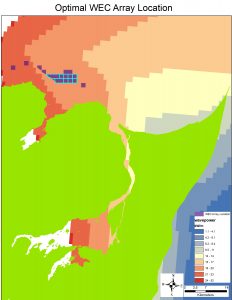At this point, we needed to provide energy estimates as to how much power could be generated from an array of WECs located in an area that scored high in our wave MCE. The area seen below was chosen due to its high MCE score and proximity to the urban centers of Masset and Old Masset. The selected polygons represent the area that would be modeled for its energy capacity if a line of Pelamis WEC devices were to be installed. Using the measure tool in ArcMap, we determined that the area is about 8,300 meters long horizontally. Average annual wave energy potential throughout this area is 19 kW/m.
In order to determine the amount of potential generation, we made use of the capture width ratio (CWR), which is defined as the as the ratio of absorbed wave power (P, in kW) to the wave resource (J, in kW/m) multiplied by the device’s active width (B), which defined as the “width of all the components actively in the primary absorption process of the energy from the waves should be included” (Babarit 2015).
CWR = P / (J * B)
While the Pelamis device we are considering is 150 meters long, its active width is given as 15 meters. Since we know the CWR and the width for the Pelamis device we are working with, as well as the available wave resources (J), we were able to determine the amount of power generated from one Pelamis device (P).
CWR = 0.175, B = 15 meters, J = 19 kW/m
Thus, (0.175)*(15 m)*(19kW/m) = 49.875 kW for each device in this area.
Approximately 50 150 meter long WEC devices can fit in this area with reasonable space separating the individual WEC devices, thus, an array of WEC deices in this area would produce approximately:
49.875 kW * 50 = 2493.75 kW = 2.5 MW.
All definitions and values for these calculations were adopted from Babarit 2015.

